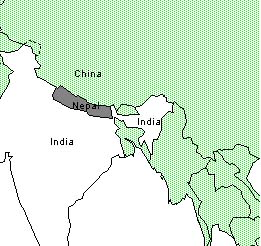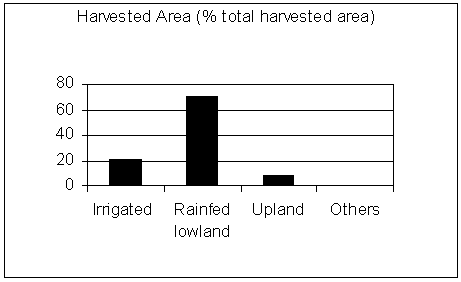General Information
· Main climates: Tropical Highland (> 1 000 m above sea), Tropical Wet and Dry

· Total land area: 13 680 000 ha
· Internal renewable water resources: 170 km3
· GNP per capita, 1998: PPP$ 1 181
· Main food consumed: Rice, Maize, Wheat, Oil & Fat, Millet & Sorghum
· Rice supply, 1999: 140 kg paddy/capita/year
Basic Statistics
|
|
1985 |
1990 |
1995 |
2000 |
|
RICE |
|
|
|
|
|
Harvested area (T ha) |
1391 |
1455 |
1496 |
1550 |
|
Yield (kg/ha) |
2016 |
2406 |
2391 |
2600 |
|
Production (T t) |
2804 |
3502 |
3578 |
4030 |
|
Imports (T t) |
7.41 |
11.59 |
40.00 |
NA |
|
Exports (T t) |
59.07 |
0 |
0 |
NA |
|
OTHERS |
|
|
|
|
|
Population (M) |
16.50 |
18.77 |
21.27 |
NA |
|
Agr population (M) |
15.45 |
17.58 |
19.86 |
NA |
|
Irrigated agr area (T ha) |
760 |
950 |
1134 |
NA |
|
Fertilizer cons (T t) |
43.40 |
72.68 |
93.69 |
NA |
|
Agr tractors in use (T units) |
183 |
182 |
172 |
NA |
Producing Zones and Cropping Seasons
Rice is planted in almost all districts. The following table shows the rice-harvested areas in different producing zones.
|
Production zone |
Harvested area (% total harvested area) |
|
Jhapa |
7.64 |
|
Morang |
7.57 |
|
Kapibastu |
6.40 |
|
Septari |
5.98 |
|
Nawalparasi |
5.44 |
|
Sihara |
5.11 |
|
Rupandehi |
5.10 |
|
Dhanusha |
4.69 |
|
Sarlahi |
4.47 |
|
Mahottari |
4.35 |
|
Sunsari |
4.23 |
|
Bara |
4.15 |
|
Rautahat |
4.08 |
|
Parsa |
3.76 |
|
Chitwan |
2.60 |
|
Nuwakot |
1.31 |
|
Udayapur |
1.30 |
|
Tanahu |
1.26 |
|
Dhading |
1.24 |
|
Bhojpur |
1.20 |
|
Kaski |
1.17 |
|
Gorkha |
1.12 |
|
Ilam |
1.01 |
|
Karve |
1.00 |
|
Sinduli |
0.98 |
|
Sindhupalchok |
0.85 |
|
Syangja |
0.85 |
|
Sanhuwasabha |
0.84 |
|
Lamjung |
0.81 |
|
Khotang |
0.77 |
|
Panchtnar |
0.76 |
|
Palpa |
0.71 |
|
Dhankuta |
0.71 |
|
Makwanpur |
0.69 |
|
Gulmi |
0.66 |
|
Thrathum |
0.65 |
|
Kathmandu |
0.59 |
|
Baglung |
0.56 |
|
Paarbat |
0.52 |
|
Taplejung |
0.49 |
|
Ramechap |
0.47 |
|
Pyuthan |
0.44 |
|
Okhaldhunga |
0.42 |
|
Arghakhanchi |
0.41 |
|
Bhaktapur |
0.41 |
|
Dolakha |
0.37 |
|
Latipur |
0.35 |
|
Myagdi |
0.24 |
|
Rolpa |
0.17 |
|
Rukum |
0.13% |
|
Rasuwa |
0.12% |
|
Solukhumbu |
0.11% |
The main rice-cropping season takes place during the rainy season. In some place a second rice crop is planted.
|
|
Planting |
Harvesting |
|
Main season |
6-7 |
10-11 |
|
Second (spring) season |
2-3 |
6-7 |
Production Practices
The following figure shows the harvested areas from different rice ecologies during 1995-2000 period.

The rice production environments are also broadly classified into Terai (60-900 m above sea, 70 percent of the total area), Inner Terai (between Chure and Mahabharat range, 100-900 m above sea, 5 percent of the total area), Mid-Hills (1 100-1 500 m above sea, 23 percent of the total area) and High Hills (1 500 m above sea, 2 percent of the total area). Rice-Wheat is the predominant cropping pattern in Nepal. Rice-Rice-Wheat, Rice-Rice-Fallow, Rice/Lentil, Rice-Wheat-Mung-bean, Rice-Maize, Rice-Chickpea, and Rice-Mustard-Maize are other cropping patterns prevailing in Nepal. So far, 38 high yielding varieties (HYV) of rice have been released for cultivation. About 50 percent of the rice area are planted to HYV. Variety CH 45 is a popular spring rice variety in Terai, but it has been partly replaced by Chaite 2 and Chaite 4. Bindeswari is grown in rainfed lowland during main season, although it was released for the spring season. Masuli (or Mahsuri), that was released in 1973, is still popular despite its susceptibility to blast and bacterial leaf blight. Rice variety Savitri is slowly replacing Masuli in central and western Terai regions. Makawanpur-1 originally released for the gallmidge-infested area of Makawanpur district is spreading in central Terai and river valleys. Janaki has become extremely popular in the Banke district, mid-western Terai. Ghaiya 2, an upland variety, is also grown under irrigated conditions in spring season. In the mid-hills, Pokhareli Masino, Taichung 176 (especially in Kathmandu valley) and Khumal 4 are extremely popular.
· Known planted irrigated and rainfed lowland varieties
|
Variety Name |
Season and/or location planted |
Growth duration (days) |
|
Barkhe 2 |
|
NA |
|
Bindeswari (or IET 1444) |
Spring, Terai |
|
|
CH 45 |
Spring, Terai |
|
|
Chaite 4 (or IR 9729-67-3) |
Spring, Terai |
|
|
Chaite-6 |
|
110-125 |
|
Chhomrong |
|
164 |
|
IR 13155 |
NA |
|
|
IR 44595 |
NA |
|
|
IR 8423 |
Main season |
NA |
|
Janaki (or BG 90-2) |
Main season |
130 |
|
Khumal-5 |
|
156 |
|
Khumal-7 |
|
149 |
|
Khumal-9 |
|
151 |
|
Laxmi |
|
NA |
|
Machhapuchhre-3 |
|
174 |
|
Mahsuri |
Main season |
125 |
|
Makawanpur-1 (or BG 400-1) |
Main season |
NA |
|
Radha 17 |
Main season |
135-140 |
|
Radha 9 |
Main season |
NA |
|
Radha 11 |
|
145-150 |
|
Radha 12 |
|
150-155 |
|
Radha 4 |
|
125-130 |
|
Radha-7 |
|
135-140 |
|
Sabitri |
|
NA |
|
Savitri (or IR2071-124-6-4) |
Main season |
NA |
Known planted upland varieties
|
Variety Name |
Season and/or location planted |
Growth duration (days) |
|
Ghaiya-2 (Mw10) |
NA |
NA |
|
Khumal 4 |
Hill |
NA |
|
Pokhreli Masino |
Hill |
NA |
|
Taichung 176 |
Hill |
NA |
|
Raddha Krishna-9 |
NA |
135-140 |
Land preparation is done mostly with animal traction. Manual transplanting is the dominant crop establishment method in lowland ecologies, while direct seeding of seeds to dry soils is dominant in upland ecologies. Large quantity of dung is available annually from cattle and buffalo population (about 39 million tons). The use of dung as a natural fertilizer plays a key role for sustainable crop production and productivity in Nepal. There is price subsidy in urea and transportation subsidy on chemical fertilizers. Farmers are using more fertilizer on rice than before. However, information on rice responses to fertilizer is not widely available.
Constraints and Issues of Sustainable Production
Drought and prolonged submergence due to unpredictable and erratic rainfall.
Zinc deficiency has been increasingly common.
Cold injury in the hills and strong wind and hail storms.
Gundhi bug (Leptocorisa acuta), hispa (Dicladispa armigera), mealybug (Ripersia oryzae), plant hoppers (Nephotettix apicalis, Sogatella fercifera and Ceeadela spectra) yellow stem borer, striped borer and army borer (Mythimna seprata).
Blast, bacterial blight, and sheath blight.
Farmers' preference to grow tall varieties with high straw yields to provide feed to livestock. Rice straw meets about 32-37% of total digestible nutrients required for several million livestock units, especially during scarcity of green fodder. It is also used as bedding materials for livestock in winter, thatching for house and raw materials for compost making and paper industries.
The following table shows the rice production costs.
|
Other information |
Yield (T/ha) |
Cost ($/ha) |
Cost ($/T) |
|
Anandban, 1987, irrigated |
2.88 |
216 |
75 |
|
Bhaktipur, 1987, irrigated |
2.4 |
177 |
74 |
|
Ramapur, 1987, rainfed lowland |
2.22 |
154 |
69 |
|
Sahebganj, 1987, rainfed lowland |
1.9 |
164 |
86 |
The gaps between potential rice yields and actual yields under Terai and mid-hill conditions are about 1.8 to 2.2 t/ha, which indicates a great potential for increasing rice production in the country. Introduction of appropriate crop management technologies and approaches are needed for narrowing the gaps and increasing production. In order to make rice production more productive and effective, further attention needs to be made to integrate agricultural credit with farming needs.
Research and Development Institutes
The Coordinated Rice Research Program was established in 1972 with its headquarter at Parwanipur Agriculture Station, 260 Km south west of Kathmandu. The Department of Agricultural Development has the extension mandate. There are thirteen agricultural research stations around the country. Each district has a district development office. Regularly known institutions are:
· Central Plant Breeding & Biotechnology Division P.O. Box 1135 Kathmandu Phone: 521614
· Lumle Agriculture Centre Lumle, Kaski
· Regional Seed Testing Laboratory Nepalgunj Agriculture Station, Khajura, Nepalgung Banke
· Regional Seed Testing Laboratory Tarahara Agriculture Station, Tarahara, Sunsari Biretnagar
· National Agricultural Research Co-ordination Committee, Ministry of Agriculture, Singh Durbar, Katmandu, Nepal.
· Regional Agricultural Research Centre, Parwanipur, P.O. Box 4, Birganj, Nepal.
· Agricultural Research Station Jumla
· Agriculture Input Corporation P.O. Box 195 Teku, Kuleswor, Kathmandu Phone: (2) 11541 Telex: 2215 KRISAK NP
· Dasharathpur Agriculture Station Dashrathpur
· Kakani Agricultural Farm Chandragangi, Jhapa
· National Agriculture Research Centre Agronomy Division Khumaltar, Lalitpur Fax: (977-1) 521197
· Nepal Seed Company Pvt. Ltd. G.P.O. Box 214 3/469 Pulchok, Lalipur Kathmandu
· Seed Testing Laboratory Hetauda Industrial Estate Hetauda, Makawanpur
· National Rice Improvement Programme Parwanipur Agriculture Station Parwanipur, Bara